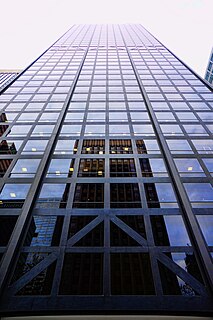 W
W140 William Street is a 41-storey steel, concrete and glass building located in the eastern side of the central business district of Melbourne, Victoria, Australia. Constructed between 1969 and 1972, BHP House was designed by the architectural practice Yuncken Freeman alongside engineers Irwinconsult, with heavy influence of contemporary skyscrapers in Chicago, Illinois. The local architects sought technical advice from Bangladeshi-American structural engineer Fazlur Rahman Khan, of renowned American architectural firm Skidmore, Owings & Merrill (SOM), spending 10 weeks at their Chicago office in 1968. At the time, BHP House was known to be the tallest steel framed building and the first office building in Australia to use a “total energy concept” – the generation of its own electricity using BHP natural gas. The name BHP House came from the building being the national headquarters of the Broken Hill Proprietary (BHP) Company. BHP House has been included in the Victorian Heritage Register for significance to the State of Victoria for following three reasons:Architectural – 140 William Street is one of the most noteworthy building designs by the Melbourne firm Yuncken Freeman. Technological – Its innovative structural application of steel and concrete, leading to open floor plates that are now a standard feature of high rise office buildings. Historical – The building signifies changes in Melbourne's CBD as it transformed into a major corporate centre.
 W
WA crescograph is a device for measuring the growth in plants. It was invented in the early 20th century by Sir Jagadish Chandra Bose.
 W
WA crystal detector is an electronic component used in some early 20th century radio receivers that consists of a piece of crystalline mineral which rectifies the alternating current radio signal and was employed as a detector (demodulator) to extract the audio modulation to produce the sound in the earphones. It was the first type of semiconductor diode, and one of the first semiconductor electronic devices. The most common type was the so-called cat whisker detector, which consisted of a piece of crystalline mineral, usually galena, with a fine wire touching its surface.
 W
WA crystal radio receiver, also called a crystal set, is a simple radio receiver, popular in the early days of radio. It uses only the power of the received radio signal to produce sound, needing no external power. It is named for its most important component, a crystal detector, originally made from a piece of crystalline mineral such as galena. This component is now called a diode.
 W
WFlush deck is a term in naval architecture. It can refer to any deck of a ship which is continuous from stem to stern. It has two specific common referents:Flush deck aircraft carriers are those with no island superstructure, so that the top deck of the vessel consists of only an unbroken flight deck. "Flush deckers" is a common nickname for a series of American destroyers built in large quantities during or shortly after World War I – the Caldwell, Wickes, and Clemson classes – so called because they lacked the raised forecastle of preceding American destroyers, thus the main deck was a flush deck.
 W
WA horn antenna or microwave horn is an antenna that consists of a flaring metal waveguide shaped like a horn to direct radio waves in a beam. Horns are widely used as antennas at UHF and microwave frequencies, above 300 MHz. They are used as feed antennas for larger antenna structures such as parabolic antennas, as standard calibration antennas to measure the gain of other antennas, and as directive antennas for such devices as radar guns, automatic door openers, and microwave radiometers. Their advantages are moderate directivity, low standing wave ratio (SWR), broad bandwidth, and simple construction and adjustment.
 W
WThe John Hancock Center is a 100-story, 1,128-foot supertall skyscraper located in Chicago, Illinois. Located in the Magnificent Mile district, its name was changed to 875 North Michigan Avenue on February 12, 2018. Despite this, the building is still colloquially called the John Hancock Center.
 W
WKing Abdulaziz University (KAU) is a public university in Jeddah, Saudi Arabia. It was established in 1967 as a private university, by a group of businessmen led by Muhammad Abu Bakr Bakhashab and including writer Hamza Bogary. In 1974, King Abdulaziz University was converted to a public university by a decision of the Council Ministers of Saudi Arabia under then-King Faisal's orders. In 2021, it is ranked the #1 Arab university by Times Higher Education. King Abdulaziz University has been placed in the top 200 universities in the world by four major ranking tables.
 W
WThe Hubert H. Humphrey Metrodome was a domed sports stadium located in downtown Minneapolis, Minnesota. It opened in 1982 as a replacement for Metropolitan Stadium, the former home of the National Football League's (NFL) Minnesota Vikings and Major League Baseball's (MLB) Minnesota Twins, and Memorial Stadium, the former home of the Minnesota Golden Gophers football team.
 W
WMicrofinance is a category of financial services targeting individuals and small businesses who lack access to conventional banking and related services. Microfinance includes microcredit, the provision of small loans to poor clients; savings and checking accounts; microinsurance; and payment systems, among other services. Microfinance services are designed to reach excluded customers, usually poorer population segments, possibly socially marginalized, or geographically more isolated, and to help them become self-sufficient.
 W
WMuslin is a cotton fabric of plain weave. It is made in a wide range of weights from delicate sheers to coarse sheeting. It gets its name from the city of Mosul, Iraq which the Europeans believed to be its place of origin, however, its origins have now proved to have been farther east — in particular Dhaka in Bangladesh.
 W
WOne Magnificent Mile is a mixed-use high-rise tower completed in 1983 at the northern end of Michigan Avenue on the Magnificent Mile in Chicago containing upscale retailers on the ground floor, followed by office space above that and luxury condominium apartments on top. The 57-storey building was designed by Skidmore, Owings & Merrill and at the time of construction was the tenth-tallest building in Chicago.
 W
WThe Onterie Center is a sixty-story award-winning high rise in downtown Chicago, Illinois, United States. It is located at 441 East Erie St, and takes its name from a conflation of "Ontario" and "Erie", the streets at its two entrances.
 W
WThe Sonali Bag or Golden Bag is a cellulose-based biodegradable bioplastic alternative to plastic bags, particularly polythene bags, developed in Bangladesh by Mubarak Ahmad Khan. The cellulose used in Sonali Bags is extracted from jute, a major vegetable fiber crop grown across the globe.
 W
WIn structural engineering, the tube is a system where, to resist lateral loads, a building is designed to act like a hollow cylinder, cantilevered perpendicular to the ground. This system was introduced by Fazlur Rahman Khan while at the architectural firm Skidmore, Owings & Merrill (SOM), in their Chicago office. The first example of the tube’s use is the 43-story Khan-designed DeWitt-Chestnut Apartment Building, since renamed Plaza on DeWitt, in Chicago, Illinois, finished in 1966.
 W
WU.S. Bank Center is a skyscraper located in downtown Milwaukee, Wisconsin, noted for being the tallest building in the state of Wisconsin, and the tallest building between Chicago and Minneapolis. Standing 601 feet (183 m) and 42 stories tall, the building has a floor area of 1,077,607 sq ft (100,113.0 m2) and it surpassed the Milwaukee City Hall as the tallest building in both the city and the state. Topped off August 29, 1972, and completed in 1973, it was the headquarters for what eventually became Firstar Corporation from 1973 to 2001. The building was designed by Colombian-Peruvian architect Bruce Graham with James DeStefano of Skidmore, Owings & Merrill, and engineered by Bangladeshi-American structural engineer Fazlur Rahman Khan. As of 2017, the building is home to the headquarters of Foley & Lardner, Robert W. Baird & Company, Sensient Technologies Corporation, and is the Milwaukee office for U.S. Bank, IBM, and CBRE.
 W
WThe Willis Tower is a 110-story, 1,450-foot (442.1 m) skyscraper in Chicago. At completion in 1973, it surpassed the World Trade Center in New York City to become the tallest building in the world, a title that it held for nearly 25 years; it was also the tallest building in the Western Hemisphere for 41 years, until the new One World Trade Center surpassed it in 2013.